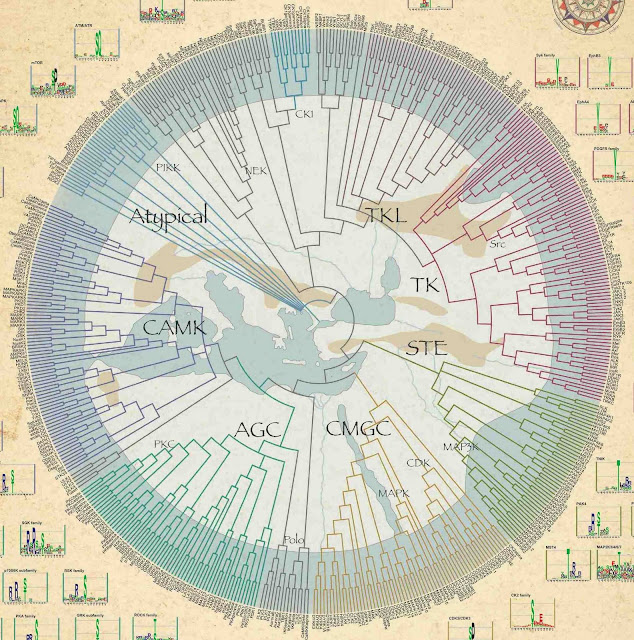Richer Fuller Lives: What Can We Learn from Einstein's Brain?
Exceptional brains appear to see more of the big picture earlier, and to exhibit a greater resistance to dementia in later life. Why are some brains exceptional, and is it possible to learn enough about the genetics of brain anatomy and function to bring more human brains into an exceptional state of function?
Detailed photographs of the brain of Albert Einstein taken at post-mortem have recently been re-examined by scientists, in an attempt to understand the differences in brain structure which contributed to the physicist's exceptional life and contributions to human knowledge. Einstein's brain displayed some remarkable features which were summarised in the images above, and in the caption below.
(A) Figure 2 [see image above] of the left lateral surface of Einstein’s brain highlighted to summarize interesting features, which have been darkened. These include a connected precentral superior and inferior sulcus, a long unnamed sulcus in the inferior primary somatosensory cortex, and a posterior ascending limb of the Sylvian fissure that, contrary to the literature, is not confluent with the postcentral inferior sulcus. Unusually expanded primary somatosensory (posterior to the central sulcus) and primary motor cortices (rectangular region below the precentral inferior sulcus) are highlighted in yellow, as are the unusually convoluted surface of the pars triangularis (part of Broca’s speech area) and the frontal polar region.
(B) Figure 7 of an occipital view of Einstein’s brain coloured to indicate the approximate boundaries of the superior parietal lobule (purple), inferior parietal lobule (aqua/blue) and occipital lobes (salmon). Presence of four transverse occipital sulci (darkened) is extremely rare, if not unique. Parts of the posterior temporal lobes are uncoloured below the inferior parietal lobules and rostral to the occipital lobes. Although the small striped patch between the superior and inferior parietal lobules on the right belongs with the superior parietal lobule rather than the angular gyrus of the inferior parietal lobule, its relationship with the bordering intraparietal sulcus is usually associated with a location in the angular gyrus. It would therefore be interesting to study the cytoarchitecture of this enigmatic patch of cortex. Notice that the inferior parietal lobule is favoured on the left (and see Fig. 4), while the superior parietal lobule is relatively greater on the right. There is also an asymmetry that favours the right posterior temporal region, and the right occipital lobe is shifted forward relative to the left.
(C) Figure 2 of the right lateral surface of Einstein’s brain highlighted to summarize interesting features, including sulci that are darkened. Unusual sulcal patterns include a connected precentral superior and inferior sulcus, a caudal segment of the inferior frontal sulcus that is connected with both the diagonal and precentral inferior sulci, and a long midfrontal sulcus that terminates in the fronto-marginal sulcus of Wernicke. The midfrontal sulcus divides the middle frontal region into two distinct gyri (highlighted in yellow), which causes Einstein’s right frontal lobe to have four rather than the typical three gyri. The enlarged ‘knob’ that probably represents motor cortex for the left hand and the highly convoluted frontal polar region are also highlighted in yellow.
(D) Figure 8 of the right medial surface of Einstein’s brain with unusual features highlighted in yellow. The cingulate gyrus has a long unnamed sulcus, the transverse parietal sulcus seems relatively elongated and the cuneus appears to be unusually convoluted.
(E) Figure 6 of the basal surface of Einstein’s brain highlighted to show that the left collateral sulcus is divided into two segments, and that part of the fusiform gyrus bridges between these segments to merge with the parahippocampal gyrus.
(F) Figure 8 of the left medial surface of Einstein’s brain with unusual features highlighted in yellow. The cingulate gyrus has a long unnamed sulcus, and the cingulate sulcus gives off four inferiorly directed branches (two of which are tiny), which suggest that the cingulate gyrus may be relatively convoluted. The cuneus appears to be unusually convoluted. The figures are reproduced with permission from the National Museum of Health and Medicine. _Cerebral Cortex of Albert Einstein _ Oxford Journals
Figure 8 from the recent journal Brain study of Einstein's brain photographs is only partially described in the captions "D" and "F" above. The photographs reveal far more detail than the drawings.
Both brain volume and brain gyral patterns are under significant genetic control (PDF), although brain volume heritability appears to be greater -- over 90%. Heritability of brain gyral patterns may be closer to 50%.
One interesting gyral pattern variation is the presence or absence of a "paracingulate gyrus" which exists in many people in parallel with the cingulate gyrus. Einstein appears to demonstrate some very interesting variations on the cingulate / paracingulate pattern.
In dementia of various types, brain volume tends to shrink significantly, along with a number of other gross and microscopic changes in morphology. All of these structural changes are also accompanied by changes in gene expression in both neurons and in glial support cells.
The question then arises as to how we might be able to influence gene expression -- in both the healthy and the diseased brain -- in order to improve brain function above and beyond what is currently being experienced.
A rich and full life benefits not only from many years of existence, but also from a depth of understanding of the world around us. Understanding exceptional brains such as Einstein's, may help us to learn what we need to do to enrich the lives of more ordinary humans.
Labels: brain rejuvenation, genetics
















